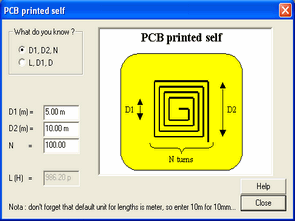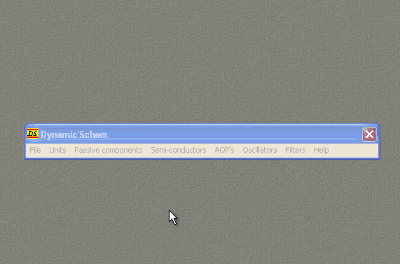
Multi-function electronic calculator program is a great source of most excellent C + + files are present in C + + programs can be developed with a lot of new features can be added. Cooler, zener, resistance, filter, and a lot more can be done calculation program does not require installation.

Electronic Calculator Dynamic Schem Overview
Dynamic’Schem is an integrated tool for electronic hobbists or students, allowing to execute quickly useful calculations needed for all kind of basic circuits :
- Ohm’s law calculations
- Serial/Parallel combinations
- Selfs calculations
- Zener diodes calculation
- Class A transistor stage calculation
- Operational amplifier circuits
- Oscillator circuits
- Filters
- etc
Dynamic’Schem is in fact the electronic form of a classic formula book ! Keep it available when you are designing your new circuit, and enjoy !
Dynamic’Schem is composed of a set of independant modules, each module being used for a specific calculation.
Each module use the same technique : A diagram shows the schematic we are talking about, Some check-boxes allow you to select which data are already known and which should be computed, Dynamic’Schem automaticaly put in grey the data that are automaticaly computed,
You enter in the non-greyed edit zones the values of the data you already know, and you get the results in the other edit zones each time you press return (easier to try than to explain…)
The Class A transistor amplifier module is a little different : due to the large number of parameters, the results are put in a scrolling list… but the principle stay the same.
The interesting thing is that you can freely modify any data, and got immediatly the according changes on the calculated values, or change the calculation mode without changing the values !
Ohm’s law: The ohm’s law module calculate the very basic relationships around voltage applied to a gicen resistor, current going through it and power dissipated.
Two resistors: The two-resistors module calculate global resistance, individual current and individual voltages accross a network of two resistors, in serial or parallel mode.
Two capacitors: The two-capacitors module calculate global capacitance and individual voltages accross a network of two capacitors, in serial or parallel mode.
Decibel calculations: The decibel module calculate relationship between an input signal level (and associated power) and the output equivalents with the gain in decibel of the amplifying/consumming apparatus.
Cylindric self, monocoated: The cylindric self-monocoated module calculate the inductance of a self made by N turn of a wire around a cylinder, all wires being all together (only one coat).
Cylindric self, multicoated: The cylindric self-multicoated module calculate the inductance of a self made by N turn of a wire around a cylinder, several coats being put one upon the other (thus the diameter of the wires is not constant).
PCB printed self: The PCB printed self module calculate the inductance of a self printed on a PCB, with square turns regularly spaced.
Filtering capacitor: The Filtering capacitor module calculate the value of a power supply filtering capacitor, giving the wanted ouput voltage residual oscillation.
Heatsink calculations: The Heatsink calculations module calculate the needed heatsink performances required for a given transistor or other active component.
Zener diode: The Zener diode module calculate the resistor value needed to polarize a zener diode, and the available output current, given the zener diode parameters and the supply voltage.
Class A amplifier stage: The Class A amplifier stage module calculate the components needed to implement a class A amplifier built around a NPN transistor, and gives the operating parameters of this stage.
AOP inverting stage: The AOP inverting stage module calculate the resistors values needed for a given inverting amplifier stage built around an operational amplifier.
AOP non-inverting stage: The AOP non-inverting stage module calculate the resistors values needed for a given non-inverting amplifier stage built around an operational amplifier.
AOP differentiator: The AOP differentiator module calculate the components value of a differentiator stage built around an operational amplifier. It is an inverting differentiator : it gives a negative signal when the input signal climbs.
AOP integrator: The AOP integrator module calculate the components value of a integrator stage built around an operational amplifier. It is an inverting integrator.
AOP summator: The AOP summator module calculate the components value of a summator stage built around an operational amplifier. It is an inverting summator, the output signal is given
AOP substractor: The AOP substrator module calculate the components value of a substrator stage built around an operational amplifier. The output signal is given by :
AOP schmitt trigger: The AOP schmitt trigger module calculate the components values of an operational amplifier based schmitt trigger (an hysteresis making circuit).
Its a comparator to 0V, the output value changing only when the input voltage exceed Vtrig or -Vtrig.
555’made astable oscillator: The 555’made astable oscillator module calculate the components values neeed to implement a multivibrator based on a ‘555 circuit (NE555, etc).
CMOS gates’made astable oscillator: The CMOS gates’made astable oscillator module calculate the component values of a CMOS gates based multivibrator.
555’made monostable oscillator: The 555’made monostable oscillator module calculate the component value needed to implement a monostable circuit with a ‘555 component (NE555, etc).
RLC serial resonnant oscillator: The RLC serial resonnant oscillator module calculate the resonnant frequency and the cut band width of a RLC serial circuit, as well as its impedance and phase shift at a given frequency. This kind of circuit may be used as a notch filter.
RLC parallel resonnant oscillator: The RLC parallel resonnant oscillator module calculate the resonnant frequency and the pass band width of a RLC parallel circuit, as well as its impedance and phase shift at a given frequency. This kind of circuit may be used as a band-pass filter.
RC low-pass filter (6dB/octave): The RC low-pass filter (6dB/octave) module calculate the components values or a such simpler filter, passive or active (with the addition of a followup AOP amplifier stage).
RC high-pass filter (6dB/octave): The RC high-pass filter (6dB/octave) module calculate the components values or a such simpler filter, passive or active (with the addition of a followup AOP amplifier stage).
RC notch filter (6dB/octave): The RC notch filter (6dB/octave) module calculate the components values or a double “T” notch filter, passive or active (with the addition of a followup AOP amplifier stage). This kind of filter is used to reject a given frequency from an incoming signal
LC low-pass filter (12dB/octave): The LC low-pass filter (12dB/octave) module calculate the components values of a filter made with a self and a capacitor. This kind of filter is mainly used for loudspeakers filters.
LC high-pass filter (12dB/octave): The LC high-pass filter (12dB/octave) module calculate the components values of a filter made with a self and a capacitor. This kind of filter is mainly used for loudspeakers filters.
LC band-pass filter (12dB/octave): The LC band-pass filter (12dB/octave) module calculate the components values of a filter made with a self and a capacitor. This kind of filter is mainly used for loudspeakers filters.
Active low-pass filter (24dB/octave): The Active low-pass filter (24dB/octave) module calculate the components values of a very selective active filter based on two operational amplifiers. Two response slopes are available : Bessel and Butterworth, each one being more adapted to a specific range of applications.
Active high-pass filter (24dB/octave): The Active high-pass filter (24dB/octave) module calculate the components values of a very selective active filter based on two operational amplifiers. Two response slopes are available : Bessel and Butterworth, each one being more adapted to a specific range of applications.
Copyright 1998 by Robert Lacoste – France
Dynamic’Schem may be copied and distributed freely providing that no fee is charged and it is not part of a package for which a charge is made (except reasonnable distribution costs if any).
So enjoy freely !
One restriction : Dynamic’Schem must always be distributed with its full source code (no binary only distribution) in order to be recompiled and/or maintained by the user (as I don’t intent to maintain it…).
A final note : Like everything free, Dynamic’Schem come without any form of warranty. So use it at your own risks.
Download electronic calculator
Şifre-Pass: 320volt.com
Published: 2010/12/26 Tags: electronics software tools
PIC16F877 Air RGB writing
Hello electoronic lovers.
This breaks my spare some time to compile my application I am trying to share with you.
In this article I artificially everyone said it would offer air writing application.
I first inspiration is still working on the site I bought it from.
Writing work was done in the air, but an example of a rgb thought about doing it and I tried for quite a few it
RGB writing circuit